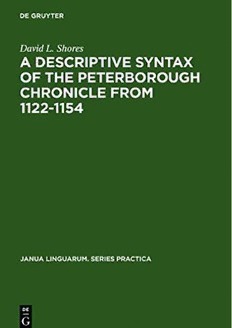
A Descriptive Syntax of the Peterborough Chronicle from 1122-1154 PDF
Preview A Descriptive Syntax of the Peterborough Chronicle from 1122-1154
A DESCRIPTIVE SYNTAX OF THE PETERBOROUGH CHRONICLE FROM 1122 TO 1154 JANUA LINGUARUM STUDIA MEMORIAE NICOLAI VAN WIJK DEDICATA edenda curat C. H. VAN SCHOONEVELD INDIANA UNIVERSITY SERIES PRACTICA 103 1971 MOUTON THE HAGUE • PARIS A DESCRIPTIVE SYNTAX OF THE PETERBOROUGH CHRONICLE FROM 1122 TO 1154 by DAVID L. SHORES OLD DOMINION UNIVERSITY 1971 MOUTON THE HAGUE · PARIS © Copyright 1971 in The Netherlands. Mouton & Co. N.V., Publishers, The Hague. No part of this book may be translated or reproduced in any form, by print, photoprint, microfilm, or any other means, without written permission from the publishers. LIBRARY OF CONGRESS CATALOG CARD NUMBER: 70-111620 Printed in The Netherlands by Mouton & Co., Printers, The Hague. For Betty my wife PREFACE In the last few years there has been a steadily growing interest in the study of early English syntax. Up until the last thirty or forty years most linguistic investigations were based on morphology and only incidentally on syntax. A brief glance at any Old or Middle English grammar will at once verify this statement. This earlier de- pendence on morphology led scholars to describe English up to the eleventh century as a language in which grammatical functions and relationships depended on inflec- tion alone — or at least, to a very large degree — and in which word order had very little significance. This and other recent studies show that this was not exactly true. If we are ever to have a complete description of early English grammar and a sound and accurate description of the nature, growth, and development of the English language, it is essential to have descriptive analyses of the various extant prose and poetic works in Old and Middle English. This study, I believe, is a valuable part of the work that is now accumulating descriptive analyses of the syntax of prose and poetic works which survived the Middle Ages. I am happy to take this opportunity to express my gratitude to Professor William J. Griffin of George Peabody College not only for suggesting valuable improvements in this study but also for introducing me to language study. I would be remiss if I did not thank Professor Sherman M. Kuhn of the University of Michigan and Professor Charles R. Carlton of San Fernando Valley State College for encouraging me to go on with this study and for supplying me with helpful in- formation. I am indebted, furthermore, to Charles Carlton, Robert Palmatier, Ann Shannon, and William Brown for ideas from their works which I used in the presen- tation of my data. I wish to thank Miss Anna Loe Russell for various kinds of cooperative and helpful assistance in locating and obtaining research materials and Louise DeVere for reading the proofs and making helpful suggestions. I would like to acknowledge the Old Dominion University Education Foundation with gratitude for supporting in part the production of this book. And, more especially, I wish to thank David, Jr., and Keith, my sons, for being patient even though they must have felt that their father was more interested in 'that δ PREFACE book' than in them, and Betty, my wife, who merits deep gratitude for being both patient and understanding. Very special mention should be made of Betty for sharing her intelligence and for laboring devotedly with the typing from the rough draft through the final copy. In short, the book could not have been finished without her. David L. Shores Norfolk, Virginia December 14,1969 CONTENTS Preface 7 List of Tables 13 1. Introduction 15 1.1. The Problem 16 1.2. The Text and Corpus 16 1.3. Importance of the Study 18 1.4. Related Research 19 1.5. Previous Studies of The Peterborough Chronicle 21 1.6. Edition of the Text 23 1.7. General Procedure of the Analysis 23 1.8. Explanation of Basic Concepts used in the Description 27 1.9. The Presentation of the Data 30 2. Primary Clause-Level Tagmemes 32 2.1. The Subject Tagmeme 32 2.1.1. The Pronoun or Modified-Pronoun Phrase 33 2.1.2. The Noun or Modified-Noun Phrase 34 2.1.3. The Nominal Clause 34 2.1.4. The Pronominal Adjective or Modified-Pronominal Adjective Phrase 35 2.1.5. The Double Subject 35 2.1.6. The Case of the Filler of the Subject Slot 35 2.1.7. Agreement with the Filler of the Predicator Slot 37 2.2. The Predicator Tagmeme 40 2.2.1. Person 40 2.2.2. Number 41 2.2.3. Tense 41 2.2.4. Passive 42
